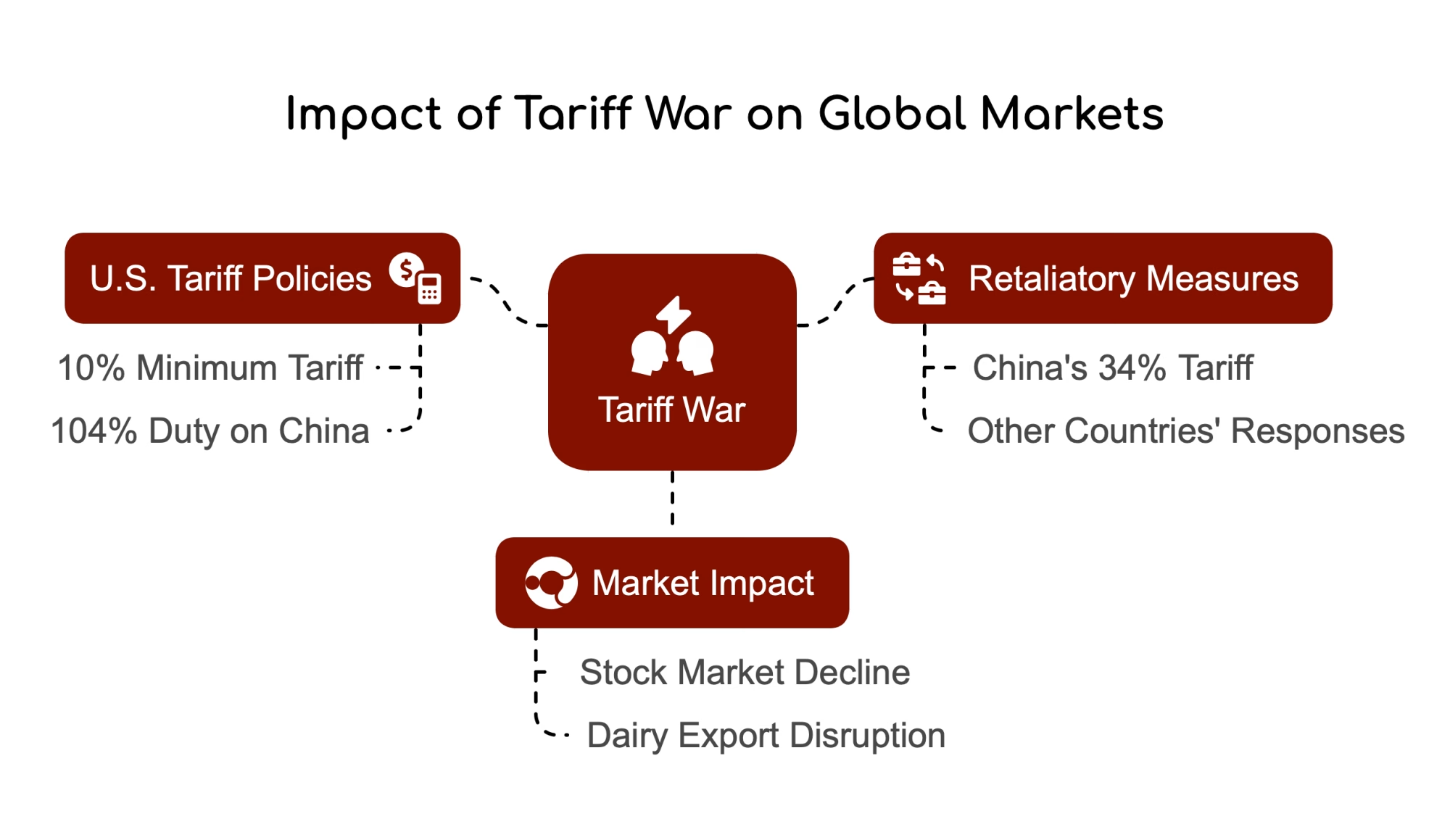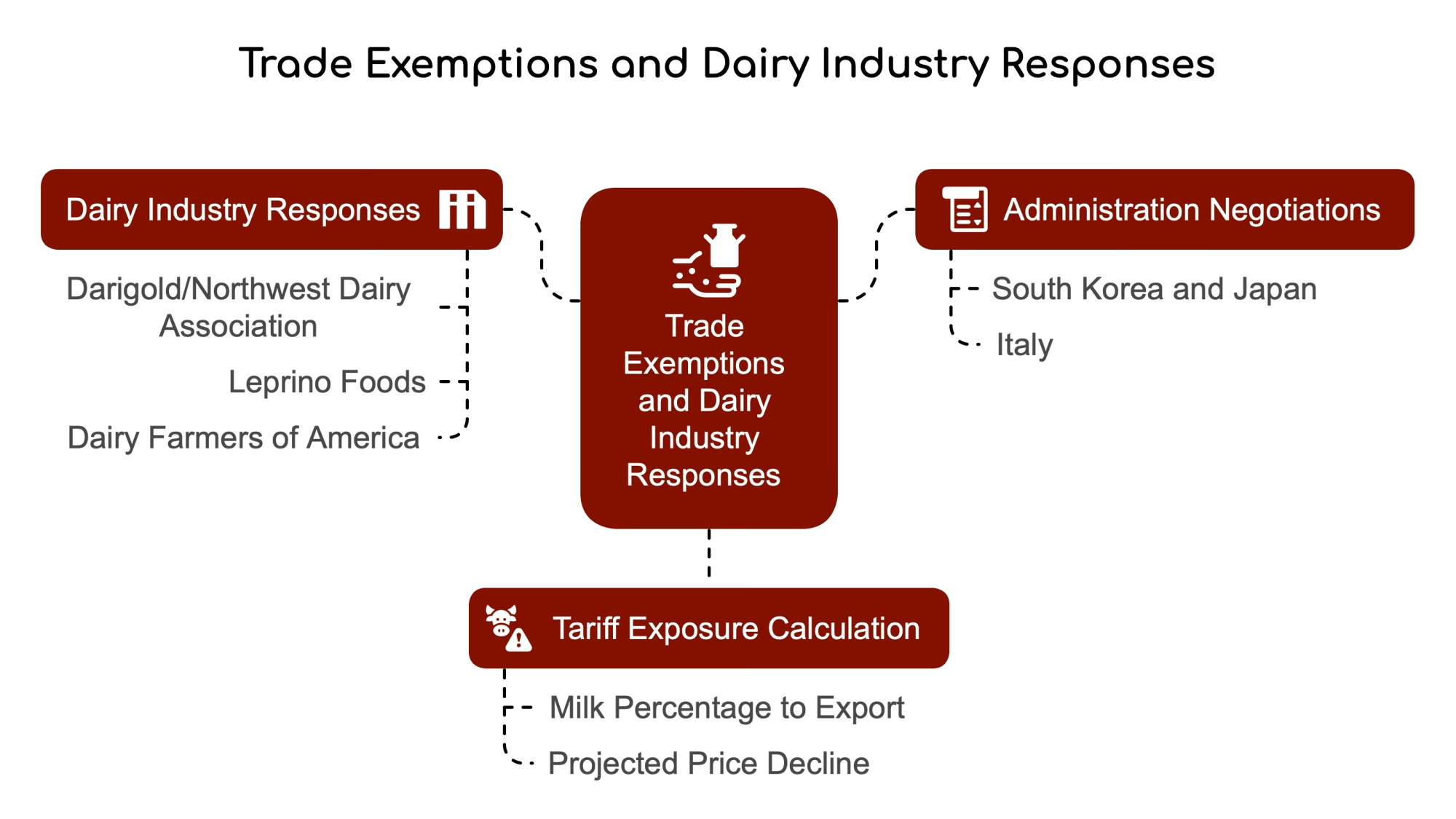Trump’s 104% tariffs rock dairy exports. Ag Secretary eyes deals by Friday. Survival strategies inside.
EXECUTIVE SUMMARY: President Trump’s sweeping tariffs, including 104% duties on Chinese imports effective immediately, have plunged dairy markets into turmoil, with $8.2B in annual exports at risk. Agriculture Secretary Brooke Rollins hints at potential trade deals by week’s end as 70 nations seek negotiations. Retaliatory measures from Canada and China threaten critical dairy sectors, while Cornell economists project B in losses over four years. Industry leaders urge farmers to lock feed costs, leverage federal programs like Dairy Margin Coverage, and diversify markets. Analysts warn of unprecedented price volatility, but strategic planning could mitigate the blow to producers.
KEY TAKEAWAYS
- Immediate Tariff Impact: 104% duties on Chinese goods and Canada’s 25% retaliatory tariffs target butter, cream, and infant formula exports.
- $6B Crisis Looming: Projected losses could erase profits for U.S. dairy through 2029 without intervention.
- Survival Playbook: Lock feed contracts, enroll in DMC/DRP programs, and pivot milk to domestic markets.
- Processor Pivot: Major exporters like Darigold and Leprino are shifting production to cushion export losses.
- Rollins’ Gamble: Potential deals with 70 nations could soften the blow – but farmers must prepare for volatility now.

As the agricultural world reels from President Trump’s sweeping tariff implementation, U.S. Agriculture Secretary Brooke Rollins has offered hope amid escalating trade tensions. Speaking Tuesday, Rollins expressed optimism that new trade agreements could materialize within days, even as significant duties on Chinese imports take effect tonight.
GLOBAL MARKETS RATTLED AS TARIFF WAR ERUPTS

President Trump’s April 2nd announcement implementing “reciprocal” tariffs has triggered market volatility and prompted immediate retaliation from key trading partners. The policy imposes a minimum 10% tariff on all imports, with additional duties reaching as high as 50% for specific countries.
After China announced retaliatory measures, the Trump administration escalated the situation by declaring 104% duties on Chinese imports, set to take effect shortly after midnight tonight. Not to be outdone, China has announced a 34% retaliatory tariff on all U.S. goods effective April 10.
STOCKS PLUNGE AS DAIRY EXPORT CHANNELS FACE EARTHQUAKE
U.S. stocks have dropped for four consecutive trading days since the initial tariff announcement, reflecting widespread economic concern. The picture is particularly troubling for dairy producers as export markets face immediate disruption.
ROLLINS PROMISES “DEALS BY FRIDAY” – CAN SHE DELIVER?

Despite mounting tensions, Secretary Rollins maintains that negotiations are progressing rapidly behind the scenes: “I believe, sincerely, it will be sooner rather than later. We’ll be hearing about new deals that are being struck, perhaps by the end of the week.”
This optimism comes with a significant revelation – 70 countries have already initiated discussions with the United States to negotiate exemptions or modifications to the tariff structure potentially.
BILLION-DOLLAR BAILOUT BACK ON THE TABLE
Critically for dairy producers, Rollins has indicated the Trump administration is preparing another round of market disruption payments if tariffs result in a downturn of agricultural exports. During Trump’s first term, the USDA provided farmers approximately $16 billion in trade assistance, with dairy receiving $2.9 billion in direct payments.
$8.2 BILLION IN DAIRY EXPORTS NOW AT RISK
The U.S. exported $8.22 billion of dairy products in 2024 alone, with Mexico, Canada, and China serving as the top destinations in dollar terms. These three markets – all targets of Trump’s tariff plan – collectively represent over half of U.S. dairy exports by value annually.
| Country | Export Value (2024) | Key Products Affected |
| Mexico | $2.47 billion | Cheese, SMP, Whey |
| Canada | $1.14 billion | Butter, Cream |
| China | $584 million | Infant Formula, Whey |
| Japan | $394.6 million | Cheese, Lactose |
THE BRUTAL NUMBERS DAIRY PRODUCERS MUST FACE:
- China (third largest export market): $584 million in U.S. dairy imports (2024)
- 26 specific dairy products are now subject to 10% Chinese tariffs, with feed whey exempted
- Historical context: 2019-2021 China tariffs cost U.S. dairy $2.6 billion in lost revenue
- Projected damage: Cornell’s Charles Nicholson forecasts $6 billion in lost dairy profits over four years
Canada has already implemented 25% retaliatory tariffs on key dairy products, including milk, cream, and butter – critical export categories directly impacting U.S. producer margins.
INDUSTRY HEAVYWEIGHTS SQUARE OFF ON TARIFF STRATEGY

The agricultural community has expressed various responses to the tariff implementation, ranging from cautious support to outright alarm.
American Farm Bureau Federation President Zippy Duvall didn’t mince words: “Tariffs will drive up the cost of critical supplies, and retaliatory tariffs will make American-grown products more expensive globally.” He emphasized that more than 20% of farm income comes from exports.
National Milk Producers Federation President Gregg Doud took a more nuanced approach: “Tariffs can be a useful tool for negotiating fairer terms of trade. To that end, we are glad to see the administration focusing on long-time barriers to trade that the European Union and India have imposed on our exports.”
U.S. Dairy Export Council President Krysta Harden similarly called for a focus on eliminating tariff and non-tariff barriers, particularly with the European Union and India.
MARKET ANALYST WARNS: “BRACE FOR PRICE WHIPLASH”
Mike North, president of Ever.Ag a sober assessment: “Predictably, this will add volatility to demand that may overshadow the ongoing focus around supply. Only small changes can have large impacts on price. Producers are well advised to brace for the disruption that these tariffs will likely create.”
| Metric | 2019-2021 China Tariffs | 2025 Projected Losses |
| U.S. Dairy Revenue | -$2.6B | -$6B (4-year estimate) |
| Milk Price Impact | -$1.20/cwt | -$2.80/cwt (projected) |
| Jobs at Risk | 4,200 | 16,500 |
With Canada implementing 25% tariffs on cream and butter, North notes these measures could significantly affect U.S. dairy prices, as Canada represents a significant export destination.
LESSONS FROM THE 2018-2021 TRADE WAR
“We’ve been here before, and the operations that survived did three things right,” explains Wisconsin dairy farmer John Vosters, who weathered the previous tariff storm. “First, they locked in feed costs early. Second, they maximized federal risk management programs. And third, they diversified their processor relationships beyond those heavily dependent on exports.”
SURVIVAL TOOLKIT: 7 CRUCIAL STEPS FOR DAIRY PRODUCERS

FINANCIAL ARMOR:
- Lock in feed contracts before potential retaliatory grain tariffs drive costs higher
- Review Dairy Margin Coverage (DMC) and Dairy Revenue Protection (DRP) options immediately
- Calculate potential 10-15% revenue impacts from top export markets
MARKET OFFENSE:
- Identify alternative domestic outlets for milk that would typically enter export channels
- Maintain close contact with processors about their export contract contingency plans
- Consider component adjustment strategies (shifting butterfat/protein ratios based on market signals) if butterfat export values decline dramatically
- Evaluate on-farm processing opportunities to capture domestic value-add potential
RISK MANAGEMENT PROGRAM DEADLINES: The 2025 enrollment period for Dairy Margin Coverage (DMC) runs from January 29 to March 31, 2025. DMC offers coverage levels ranging from $4.00 to $9.50 per hundredweight (cwt) of milk in $0.50 increments. The program provides financial protection when the margin between milk price and feed costs falls below selected coverage levels.
The Dairy Revenue Protection (DRP) program, available year-round, ensures against unexpected declines in quarterly revenue from milk sales. Producers can select coverage levels between 80% and 95% of expected revenue and choose either class or component pricing options.
ROLLINS’ GRAND VISION: BEYOND THE TARIFF BATTLE
Beyond the immediate tariff situation, Rollins has articulated an ambitious agenda to transform U.S. agricultural trade. Upon taking office, she pledged to slash the agricultural trade deficit and boost American exports across all sectors.
Her approach includes leveraging existing trade agreements like USMCA while aggressively pursuing new deals to expand market access for U.S. dairy products. “Our goal is to make ‘Made in America’ the gold standard for dairy products worldwide,” she declared.
| Metric | Pre-USMCA (2019) | Post-USMCA (2024) | Change |
| U.S. Export Value to Canada | $442M | $1.14B | +158% |
| TRQ Enforcement (Tariff-Rate Quota access) | Limited | USMCA Panel Victory | Improved |
| Canadian Market Access | Restricted | Expanded but Challenged | Ongoing |
The USMCA, signed into law in January 2020, has already shown significant benefits despite implementation challenges. The U.S. prevailed in a dispute settlement panel under USMCA when Canada was found to be breaching commitments by reserving dairy tariff-rate quotas (TRQs) for Canadian processors.
COUNTDOWN TO EXEMPTIONS: WHO’S FIRST IN LINE?

The administration has already scheduled talks with South Korea and Japan, two major trading partners. Italian Prime Minister Giorgia Meloni is due to visit next week. These discussions represent the first wave of negotiations that could potentially lead to exemptions or modifications to the tariff structure.
Secretary Rollins frames the current situation as temporary pain for long-term gain, asserting that the comprehensive approach addresses not just tariffs but also unfair trade practices and unjust trade barriers.
PROCESSOR WATCHLIST: HOW MAJOR EXPORTERS ARE RESPONDING
- Darigold/Northwest Dairy Association: Accelerating domestic market development while maintaining Asian export commitments
- Leprino Foods: Repositioning some cheese production from export to domestic food service markets
- Dairy Farmers of America: Reportedly developing contingency plans for redirecting milk supply from export-focused plants
CALCULATING YOUR FARM’S TARIFF EXPOSURE
Use this simple formula to estimate your operation’s risk:
- Determine your milk percentage going to export markets (ask your processor)
- Multiply by projected price decline ($2.80/cwt in worst-case scenario)
- Result = potential revenue impact per cwt
THE BULLVINE BOTTOM LINE: The tariff situation represents a critical moment requiring strategic navigation. Secretary Rollins’ optimism about imminent deals provides hope to prepare for increased volatility and potentially extended market disruption. Those who position strategically now – both defensively and opportunistically – will be best positioned to weather this trade storm.
THE BULLVINE VERDICT: This high-stakes trade reshuffling demands daily monitoring and nimble management. We’ll continue tracking developments, processor reactions, and market opportunities as they emerge. Buckle up – this ride just got a whole lot bumpier.
Learn more:
- Trump’s Liberation Day Tariffs: A $8.2B Gamble for Dairy Farmers
Explore how retaliatory tariffs from Canada and China threaten $8.2 billion in U.S. dairy exports, with survival strategies for farmers facing collapsing milk prices. - CAFTA-DR Unleashes U.S. Dairy Export Boom: $441M Tariff-Free Breakthrough
Learn how strategic trade agreements like CAFTA-DR reshaped U.S. dairy exports, offering insights into tariff-free market expansion opportunities. - How Trump’s Tariffs Threaten Your Herd’s Bottom Line
Dive into the global dairy trade war sparked by Trump’s tariffs, with data on vulnerable export markets and practical advice for protecting farm profitability.
 Join the Revolution!
Join the Revolution!
Join over 30,000 successful dairy professionals who rely on Bullvine Daily for their competitive edge. Delivered directly to your inbox each week, our exclusive industry insights help you make smarter decisions while saving precious hours every week. Never miss critical updates on milk production trends, breakthrough technologies, and profit-boosting strategies that top producers are already implementing. Subscribe now to transform your dairy operation’s efficiency and profitability—your future success is just one click away.







 Join the Revolution!
Join the Revolution!



